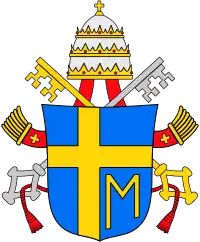
Pope John Paul II (r. 1978–2005) created 231 cardinals in nine consistories held at roughly three-year intervals. Three of those cardinals were first created in pectore, that is, without their names being announced, and only identified by the pope later. He named a fourth in pectore as well but never revealed that name. At his 2001 consistory, where he elevated 42 prelates and announced the names of two created in pectore earlier, he created more cardinals at one time than ever before or since. His consistories in 1985, 1994, and 2003 were among the largest ever.
In his first three consistories, John Paul adhered to the limit of 120 that Pope Paul VI set on the number of cardinal electors in 1975.[1] and he included that maximum when he reformed the papal conclave procedures in 1996.[2][3] His appointments exceeded that number for the first time in 1988 when the number of electors rose to 121, and then again in 1998 when it reached 122. In each of his last two consistories, in 2001 and 2003, he raised the number to 135,[4] a record figure only exceeded once, by Pope Francis in 2023.[5]
He was the first pope to allow someone not a bishop to become a cardinal since Pope John XXIII mandated that cardinals be bishops in 1962.[6] His appointments included one future pope, Pope Francis.
30 June 1979
John Paul created fourteen cardinals at his first consistory[7] and he announced he was withholding the name of a fifteenth.[8] That additional cardinal's name was not made public until 1991.[9] All those named were archbishops, including six Italians and two Poles. These appointments, excluding the name withheld, brought the number of cardinals who had not passed their 80th birthday to 120, the maximum set by Pope Paul VI, while the entire membership of the College of Cardinals reached 135.[8]
| Name | Country |
|---|---|
| Agostino Casaroli (1914–1998) | |
| Giuseppe Caprio (1914–2005) | |
| Marco Cé (1925–2014) | |
| Egano Righi-Lambertini (1906–2000) | |
| Joseph-Marie Trịnh Văn Căn (1921–1990) | |
| Ernesto Civardi (1906–1989) | |
| Ernesto Corripio y Ahumada (1919–2008) | |
| Joseph Asajiro Satowaki (1904–1996) | |
| Roger Etchegaray (1922–2019) | |
| Anastasio Ballestrero (1913–1998) | |
| Tomás Ó Fiaich (1923–1990) | |
| Gerald Emmett Carter (1912–2003) | |
| Franciszek Macharski (1927–2016) | |
| Władysław Rubin (1917–1990) |
Cardinal "in pectore"
| Name | Country | Revealed as Cardinal |
|---|---|---|
| Ignatius Kung Pin-mei (1901–2000) | 29 May 1991[10] |
2 February 1983
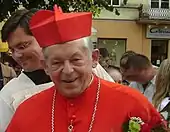
John Paul created 18 cardinals on 2 February 1983, including the first resident of the Soviet Union (Vaivods of Latvia)[11] and four others from countries with Communist governments. This brought the College to 138 members, of whom 120 were young enough to serve as electors in a papal conclave. Another cardinal was created in pectore or secretly.[12] John Paul granted a dispensation from the requirement that all cardinals be bishops to Henri de Lubac, the first such dispensation since Pope John XXIII established the rule in 1962.[13]
| Name | Country |
|---|---|
| Anthony Peter Khoraish (1907–1994) | |
| Bernard Yago (1916–1997) | |
| Aurelio Sabattani (1912–2003) | |
| Franjo Kuharić (1919–2002) | |
| Giuseppe Casoria (1908–2001) | |
| José Lebrún Moratinos (1919–2001) | |
| Joseph Bernardin (1928–1996) | |
| Michael Michai Kitbunchu (b. 1929) | |
| Alexandre do Nascimento (b. 1925) | |
| Alfonso López Trujillo (1935–2008) | |
| Godfried Danneels (1933–2019) | |
| Thomas Williams (1930–2023) | |
| Carlo Maria Martini (1927–2012) | |
| Jean-Marie Lustiger (1926–2007) | |
| Józef Glemp (1929–2013) | |
| Julijans Vaivods (1895–1990) | |
| Joachim Meisner (1933–2017) | |
| Henri de Lubac (1896–1991) |
25 May 1985
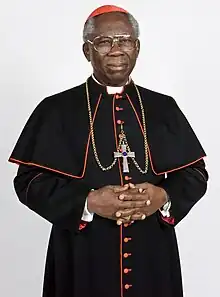

John Paul created 28 cardinals on 25 May 1985 in a ceremony held outdoors for the first time in St. Peter's Square. They included the first from Ethiopia and Nicaragua and an archbishop of the Ukrainian Rite. It raised the College's membership to 152, with 120 eligible to vote for a new pope.[14]
28 June 1988
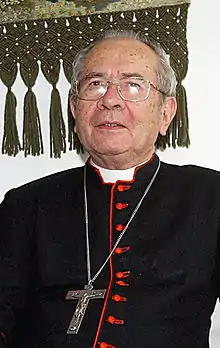
On 29 May 1988 John Paul announced he would create 25 new cardinals in 28 June, though the death of Hans Urs von Balthasar of Switzerland reduced that number to 24.[15] This consistory took the number of cardinal electors from 97 to 121, which fell within a month to the maximum of 120, a majority of them appointed by John Paul.[lower-alpha 1] It brought the total number of cardinals to a new high of 160, of whom John Paul named 84.[16]
| Name | Country |
|---|---|
| Eduardo Martínez Somalo (1927–2021) | |
| Achille Silvestrini (1923–2019) | |
| Angelo Felici (1919–2007) | |
| Paul Grégoire (1911–1993) | |
| Antony Padiyara (1921–2000) | |
| José Freire Falcão (1925–2021) | |
| Michele Giordano (1930–2010) | |
| Alexandre José Maria dos Santos (1924–2021) | |
| Giovanni Canestri (1918–2015) | |
| Antonio María Javierre Ortas (1921–2007) | |
| Simon Pimenta (1920–2013) | |
| Mario Revollo Bravo (1919–1995) | |
| Edward Bede Clancy (1923–2014) | |
| Lucas Moreira Neves (1925–2002) | |
| James Aloysius Hickey (1920–2004) | |
| Edmund Szoka (1927–2014) | |
| László Paskai (1927–2015) | |
| Christian Tumi (1930–2021) | |
| Hans Hermann Groër (1919–2003) | |
| Jacques-Paul Martin (1908–1992) | |
| Franz Hengsbach (1910–1991) | |
| Vincentas Sladkevičius (1920–2000) | |
| Jean Margéot (1916–2009) | |
| John Wu (1925–2002) |
28 June 1991
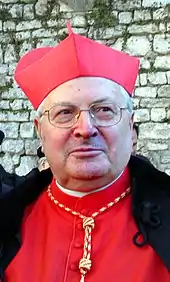
On 29 May 1991, John Paul announced he would create 22 cardinals at a consistory on 28 June and revealed the name of one he had created in pectore in 1979, Ignatius Kung Pin-mei. This increased the number of cardinal electors to 120 from 100. It also raised to 13 the number cardinals from the Soviet Union and nations of the recently dissolved Warsaw Pact.[9][17] The total number of cardinals reached 162 after the consistory.[lower-alpha 2]
| Name | Country |
|---|---|
| Angelo Sodano (1927–2022) | |
| Alexandru Todea (1912–2002) | |
| Pio Laghi (1922–2009) | |
| Edward Cassidy (1924–2021) | |
| Robert-Joseph Coffy (1920–1995) | |
| Frédéric Etsou-Nzabi-Bamungwabi (1930–2007) | |
| Nicolás de Jesús López Rodríguez (b. 1936) | |
| Jose Tomas Sanchez (1920–2012) | |
| Virgilio Noè (1922–2011) | |
| Antonio Quarracino (1923–1998) | |
| Fiorenzo Angelini (1916–2014) | |
| Roger Mahony (b. 1936) | |
| Juan Jesús Posadas Ocampo (1926–1993) | |
| Anthony Bevilacqua (1923–2012) | |
| Giovanni Saldarini (1924–2011) | |
| Cahal Daly (1917–2009) | |
| Camillo Ruini (b. 1931) | |
| Ján Chryzostom Korec (1924–2015) | |
| Henri Schwery (1932–2021) | |
| Georg Sterzinsky (1936–2011) | |
| Guido del Mestri (1911–1993) | |
| Paolo Dezza (1901–1999) |
26 November 1994
On 30 October 1994, John Paul announced the names of 30 new cardinals from 24 countries, scheduling the consistory for 26 November. He said others were deserving but he "thought it appropriate to adhere to the limit set by my Predecessor Paul VI".[18] The total number of cardinals reached 167 after the consistory.[lower-alpha 3]

-2.jpg.webp)

21 February 1998
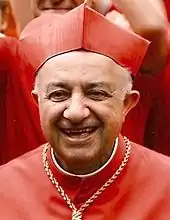
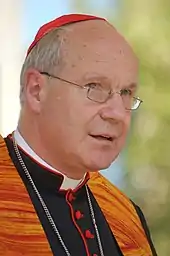
John Paul announced on 18 January 1998 that he would create 22 new cardinals, but withheld the names of two of them. He had also planned to include Josip Uhač, a Vatican diplomat and curial official who died that morning. The consistory was scheduled for 21 February.[19] Excluding the two not named, this brought the membership of the College of Cardinals to 165, of whom 122 were eligible to vote in a conclave.[20][lower-alpha 4]
| Name | Country |
|---|---|
| Jorge Medina Estévez (1926–2021) | |
| Alberto Bovone (1922–1998) | |
| Darío Castrillón Hoyos (1929–2018) | |
| Lorenzo Antonetti (1922–2013) | |
| James Stafford (b. 1932) | |
| Salvatore De Giorgi (b. 1930) | |
| Serafim Fernandes de Araújo (1924–2019) | |
| Antonio María Rouco Varela (b. 1936) | |
| Aloysius Ambrozic (1930–2011) | |
| Jean Marie Balland (1934–1998) | |
| Dionigi Tettamanzi (1934–2017) | |
| Polycarp Pengo (b. 1944) | |
| Christoph Schönborn (b. 1945) | |
| Norberto Rivera Carrera (b. 1942) | |
| Francis George (1937–2015) | |
| Paul Shan Kuo-Hsi (1924–2012) | |
| Adam Kozłowiecki (1911–2007) | |
| Giovanni Cheli (1918–2013) | |
| Francesco Colasuonno (1925–2003) | |
| Dino Monduzzi (1922–2006) |
Cardinal created "in pectore"
| Name | Country | Revealed as Cardinal |
|---|---|---|
| Marian Jaworski (1926–2020) | 29 January 2001[21] | |
| Jānis Pujats (b. 1930) |
21 February 2001

On 21 January 2001, Pope John Paul II announced plans to raise 37 prelates to the rank on cardinal at a consistory in February. He also said that at the consistory he would announce the names of two cardinals he named in pectore in 1998.[22] He followed that by announcing the names of five more on 28 January and revealed the two made cardinals secretly in 1998, Marian Jaworski and Janis Pujats.[23] The 44 cardinals created at this consistory was the largest ever created at a consistory.[24] It increased the number of cardinals eligible to vote in a papal election to 135, despite the maximum of 120 set by Pope Paul VI in 1975 and reiterated by John Paul II in 1996; he said in each of his announcements that he was setting aside this limit.[23][22][24] The total number of cardinals reached 183 after the consistory.[lower-alpha 5]
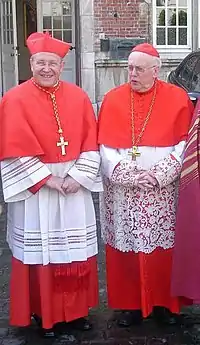

21 October 2003

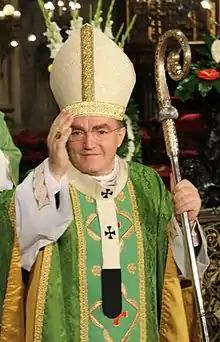
Pope John Paul II announced on 28 September 2003 that he would create 31 new cardinals in an October consistory, but withheld the name of one of them, apparently a resident of a country where Catholicism was the object of government persecution.[lower-alpha 8] Twenty-six of those publicly named were young enough to vote in a papal conclave, and seven of those were members of the Roman Curia.[26][27][28] This consistory increased the number of cardinal electors from 109 to 135.[29][30] The total number of cardinals reached 194 after the consistory.[lower-alpha 9] Because the withheld name was never published, that cardinal's appointment expired when the Pope died.
Demographic adjustment
In 2004, the birth year of Cardinal Henryk Gulbinowicz, long reported as 1928, was corrected to 1923. The adjustment meant he was past his 80th birthday and no longer counted as a cardinal elector. In 1942, as a young man, Gulbinowicz had falsified his birth records to escape being sent to a Nazi labor camp. The correct birth date was reported in the Italian press as early as March 2004[31] and printed in the Pontifical Yearbook presented to John Paul on 31 January 2005.[32][33]
See also
Notes
- ↑ Cardinal Corrado Ursi turned 80 on 28 July.
- ↑ 160 cardinals at 1988 consistory minus 21 cardinals who died before the 1991 consistory (Volk, Guyot, Dearden, de Fürstenberg, Cooray, Nasalli Rocca di Corneliano, Siri, Malula, Manning, Flahiff, Civardi, Ó Fiaich, Trịnh Văn Căn, Vaivods, Maurer, Dadaglio, Rubin, Beras Rojas, Freeman, Nsubuga, Hengsbach) plus 22 newly-appointed cardinals plus 1 revealed cardinal in pectore Kung Pin-mei.
- ↑ 162 cardinals at 1991 consistory minus 25 cardinals who died before the 1994 consistory (Salazar López, de Lubac, Léger, Guerri, Colombo, Paupini, Tomášek, Martin, Picachy, Baggio, Posadas Ocampo, Antonelli, Gray, del Mestri, Carpino, Razafimahatratra, Grégoire, Garrone, Darmojuwono, Cordeiro, Marty, McCann, Muñoz Vega, Khoraish, Decourtray) plus 30 newly-appointed cardinals.
- ↑ When the consistory was announced, it would have brought the number of cardinal electors to 123, but Eduardo Francisco Pironio died on 5 February 1998 at the age of 77.
- ↑ 165 cardinals at 1998 consistory minus 26 cardinals who died before the 2001 consistory (Quarracino, Balland, Ribeiro, Bovone, Casaroli, Carberry, Ballestrero, Grillmeier, Oviedo Cavada, Silva Henríquez, Hume, Dezza, Kung Pin-mei, Padiyara, Echeverría Ruiz, O'Connor, Sladkevičius, Zoungrana, Vargas Alzamora, Fagiolo, Gouyon, Righi-Lambertini, Palazzini, Lubachivsky, Casoria, Lebrún Moratinos) plus 42 newly-appointed cardinals plus two revealed cardinals in pectore (Jaworski and Pujats).
- ↑ resigned from the College of Cardinals in 2018; laicized in 2019.
- ↑ elected as Pope Francis (2013–present).
- ↑ John Paul never revealed this name, not even in his will.[25]
- ↑ 183 cardinals at 2001 consistory minus 19 cardinals who died before the 2003 consistory (Eyt, Winning, Oddi, Sensi, Bertoli, Kuharić, Billé, Todea, Degenhardt, Moreira Neves, Nguyễn Văn Thuận, Wu Cheng-chung, Groër, Carter, Sabattani, Colasuonno, Velasco García, Ursi, Otunga) plus 30 newly-appointed cardinals.
References
- ↑ Pope Paul VI (1 October 1975). "Romano Pontifici Eligendo". Libreria Editrice Vaticana. Retrieved 11 July 2018.
- ↑ Pope John Paul II (22 February 1996). "Universi Dominici Gregis". Libreria Editrice Vaticana. Retrieved 12 July 2018. See also: Universi Dominici Gregis.
- ↑ Allen Jr., John L. (23 July 2002). Conclave: The Politics, Personalities, and Process of the Next Papal Election. Crown Publishing. ISBN 9780385504560. Retrieved 12 July 2018.
- ↑ Wooden, Cindy (22 May 2018). "Cardinal stats: Pope makes college more international, not much younger". Crux. Catholic News Service. Archived from the original on 26 July 2018. Retrieved 26 July 2018.
- ↑ O'Connell, Gerard (30 September 2023). "Pope Francis creates 21 new cardinals from 16 nations on the eve of the Synod on Synodality". America. Retrieved 5 December 2023.
- ↑ John XXIII (15 April 1962). "Cum gravissima". Archived from the original on 2 March 2013. Retrieved 11 July 2018.
- ↑ Tanner, Henry (1 July 1979). "Pope Installs 14 Cardinals but Keeps a 15th Secret". New York Times. Retrieved 27 October 2017.
- 1 2 "Pope Names 14 New Cardinals, Including 6 Italians and 2 Poles". New York Times. 27 May 1979. Retrieved 23 October 2017.
- 1 2 Haberman, Clyde (30 May 1991). "Pope Names 22 Cardinals; Chinese Prelate Is Identified". New York Times. Retrieved 2 September 2017.
- ↑ Haberman, Clyde (30 May 1991). "Pope Names 22 Cardinals; Chinese Prelate Is Identified". New York Times. Retrieved 2 September 2017.
- ↑ Burns, John F. (9 January 1983). "Latvian Cardinal Surprise to Soviet". New York Times. Retrieved 27 October 2017.
- ↑ Kamm, Henry (3 February 1983). "Pope John Paul Installs 18 as Cardinals". New York Times. Retrieved 27 October 2017.
- ↑ Goulding, Gill K. (2015). A Church of Passion and Hope: The Formation of An Ecclesial Disposition from Ignatius Loyola to Pope Francis and the New Evangelization. Bloomsbury T&T Clark. ISBN 9780567664686. Retrieved 15 December 2017.
- ↑ Dionne Jr., E.J. (26 May 1985). "28 Consecrated 'Princes of the Church'". New York Times. Retrieved 27 October 2017.
- ↑ "24 New Cardinals Installed by Pope". New York Times. 29 June 1988. Retrieved 27 October 2017.
- ↑ Suro, Roberto (30 May 1988). "Pope Chooses 25 New Cardinals, Including Two American Prelates". New York Times. Retrieved 27 October 2017.
- ↑ "Cardinals Named by Pope". New York Times. 30 May 1991. Retrieved 2 September 2017.
- ↑ "Angelus, 30 October 1994". Libreria Editrice Vatican. 30 October 1994. Retrieved 2 September 2017.
ho ritenuto opportuno attenermi al limite fissato dal mio Predecessore Paolo VI
- ↑ "Angelus, 18 January 1998". Libreria Editrice Vatican. 18 January 1998. Retrieved 2 September 2017.
- ↑ "Messa solenne del Papa con i nuovi cardinali". La Repubblica (in Italian). 23 February 1998. Retrieved 2 September 2017.
- ↑ Stanley, Alexandra (29 January 2001). "Pope Adds 7 Cardinals to a Record 37 Chosen Last Week". New York Times. Retrieved 1 September 2016.
- 1 2 Stanley, Alexandra (22 January 2001). "37 New Cardinals Selected by Pope; Egan is Elevated". New York Times. Retrieved 1 September 2016.
- 1 2 Stanley, Alexandra (29 January 2001). "Pope Adds 7 Cardinals to a Record 37 Chosen Last Week". New York Times. Retrieved 1 September 2016.
- 1 2 Stanley, Alexandra (22 February 2001). "Shaping a Legacy, Pope Installs 44 Cardinals". New York Times. Retrieved 1 September 2016.
- ↑ Boudreaux, Richard (7 April 2005). "Mystery Cardinal Will Never Be Able to Join Peers". Los Angeles Times. Retrieved 7 September 2017.
- ↑ Bruni, Frank (29 September 2003). "Pope Names 31 Cardinals, Future Voters on Succession". New York Times. Retrieved 1 September 2016.
- ↑ "List of the 31 New Cardinals". New York Times. Reuters. 28 September 2003. Retrieved 25 August 2017.
- ↑ "The New Cardinals and Their Duties". Zenit. 21 October 2003. Retrieved 25 August 2017.
- ↑ Bruni, Frank (22 October 2003). "Pope Confirms Cardinals, As Talk Turns to Succession". New York Times. Retrieved 6 December 2017.
- ↑ Magister, Sandro (10 October 2003). "Il papa è malato. Ma anche il Vaticano non sta tanto bene". L'Espresso (in Italian). Retrieved 27 July 2018.
- ↑ "Le dimissioni di Gulbinowicz". 30 Giorni (in Italian). 1 March 2004. Archived from the original on 27 July 2018. Retrieved 26 July 2018.
- ↑ "Vatican Corrects Cardinal's Date of Birth". Zenit. Retrieved 26 July 2018.
- ↑ Bedoya, Juan G. (12 February 2005). "Arrepentimiento tardío". El País (in Spanish). Retrieved 26 July 2018.
- See also
- Lentz III, Harris M. (2002). Popes and Cardinals of the 20th Century: A Biographical Dictionary. McFarland & Company. ISBN 978-0-7864-4101-3.
